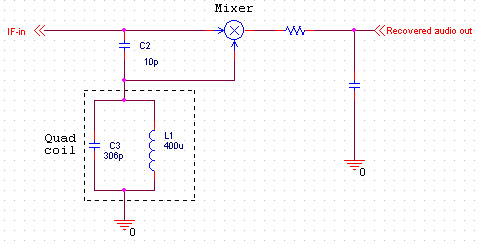BFSK Quadrature Demodulation
As related to a binary signal (BFSK) it is unclear to me how the baseband data presents it self at the IQ outputs of the demodulator.
Rich
Do you really mean a quadrature mixer with I and Q outputs. Normally a "quadrature detector" uses a single mixer with only one output, where the rf port is fed directly, and the LO port is delayed +/- in phase by an LC network.
There are other types of FSK detectors that have two outputs, and they drive a S-R flip flop. The digital portion just sees which of the two rising edges happens first, and sets the flip flop either high or low based on that.
All the quadrature detectors that I have seen use two mixers, one to mix the LO and the other to mix the LO shifted by 90 degrees. The output of each mixer forms the I and Q outputs. Often the output pins are balanced, which is the case here, so there are four IQ connections. I have attached an example of a receiver IC that has a built in quad detector.
Rich
around here, when someone asks about a FM quadrature detector, they mean this:

the "quadrature" means that at center frequency, the mixer ports are fed 90 degrees apart (so the mixer acts like a phase detector). Then small changes in input frequency result in the phase difference to the mixer ports going +/- from the 90 degree point, giving rise to a +/- output voltage.
The receiver you are referring to is a direct conversion or zero IF receiver. The output in case of BFSK depends on the exact LO offset. Assuming it's set to the center frequency of the BFSK signal, you get a baseband signal of +Δf/2 or -Δf/2. The frequency sign will be well detectable in I/Q representation as rotational direction of the complex vector.
